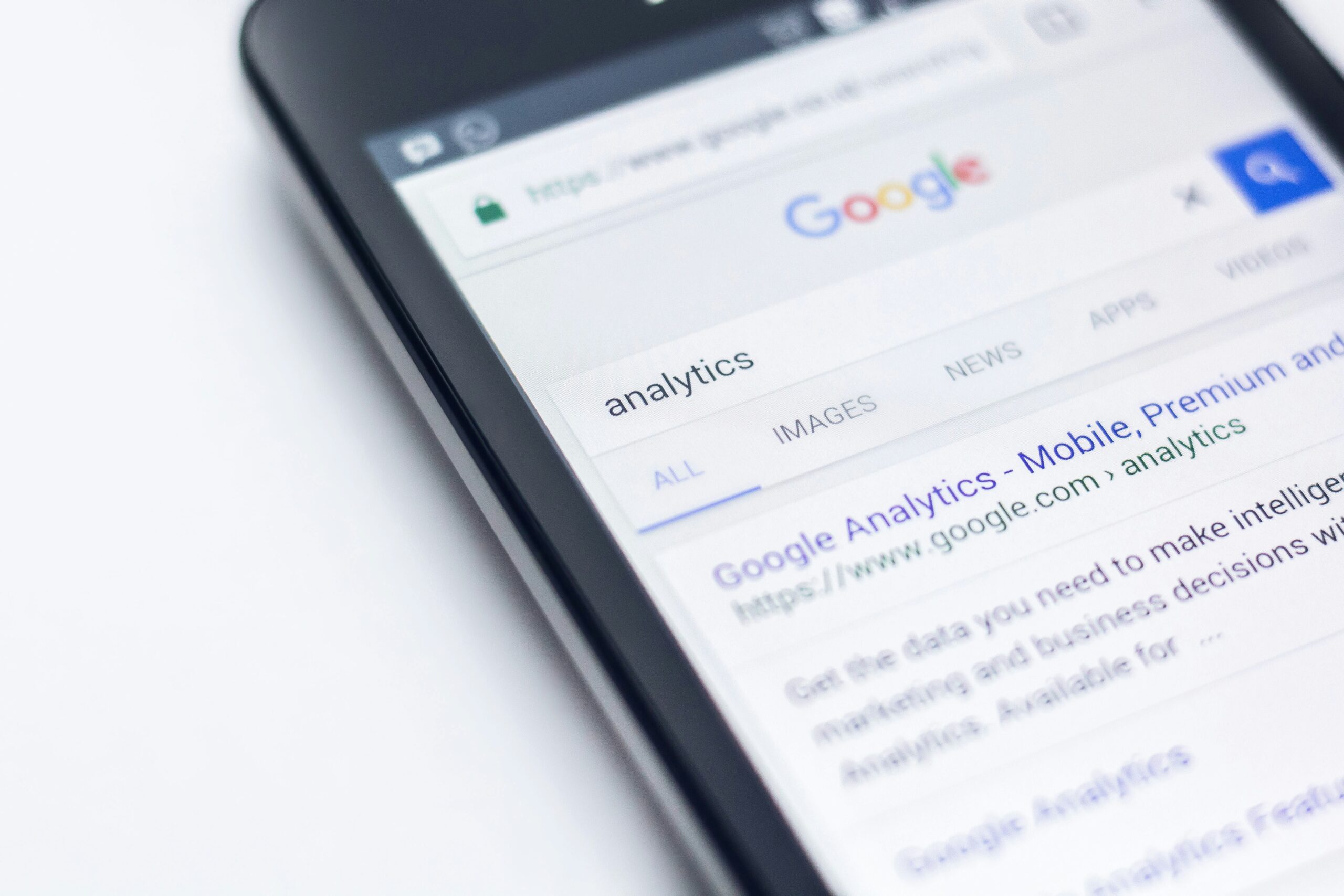Earlier this month, I had a sharing session with my mentee at ADP List where we discussed a few options to kickstart marketing or demand generation initiatives. SEM was one of the top three initiatives to validate and initiate demand gen quickly.
That session made me realize that SEM is one area where I am quite comfortable sharing with others. After running SEM campaigns for more than 5 years, I would love to share my approach here
So here we go, my SEM 101 (kind of). I will breakdown this into 4 sections with related resources:
- What is SEM? What’s the difference with SEO?
- Does SEM make sense for my company or business?
- How do I set up an SEM campaign? What are the best practices.
- What are common mistakes to avoid?
- Resources and sample.
Section 1 – What is SEM? What is the difference with SEO?
SEM stands for Search Engine Marketing, while SEO is Search Engine Optimisation. Both are completely applicable on any search engine: google, bing, baidu, etc.
Please see image below to differentiate SEM and SEO in action. Anything with a “sponsored” tag (highlighted in red) is a product of SEM, while the rest are SEO product. Both SEM and SEO are marketing initiatives that help us appear at the top of search engine results pages.
Image – SEM In action (click arrow to show)
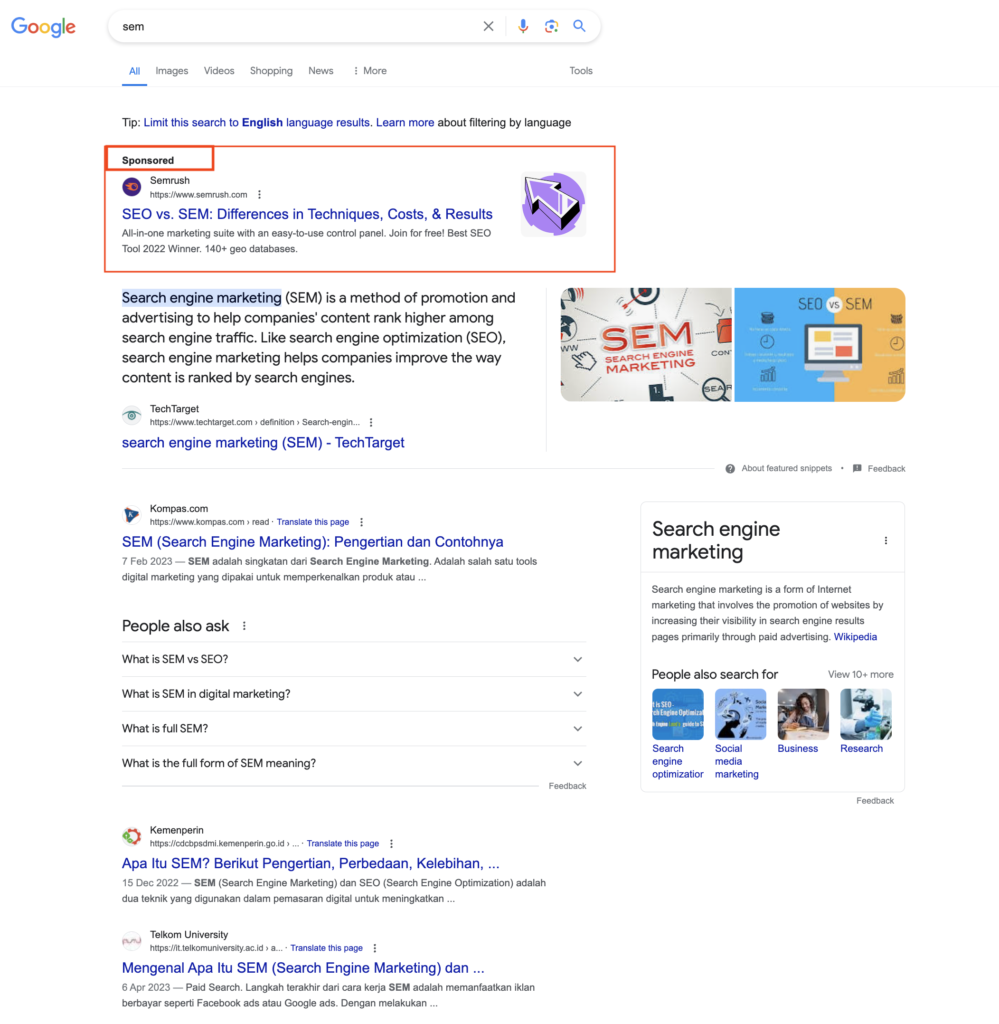
What are the difference between the two? The biggest difference is that we are paying per number of click on SEM, while we don’t pay anything to search engine anything.
Let me explain simply via this table below(Table 1.0).
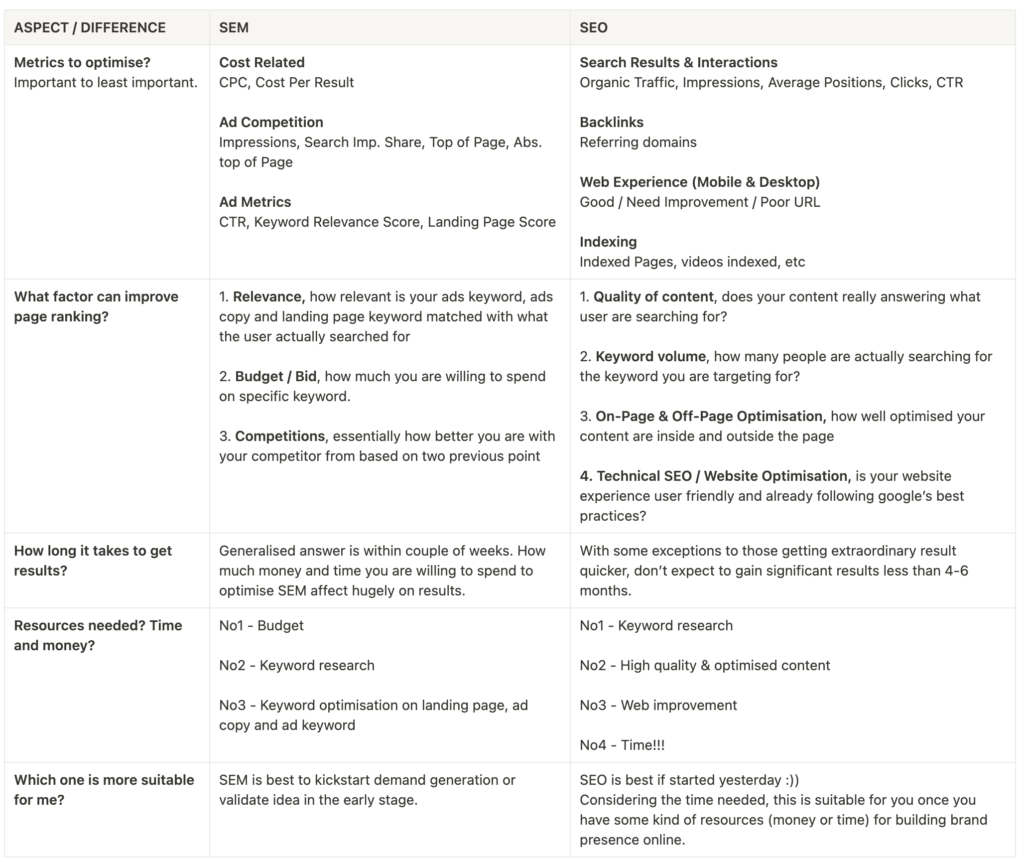
Now, onto the final question: which one is best? SEM or SEO?
It all depends on your business needs and expectations. However, I would like to emphasise it’s never about one better than the other. It is more about balancing between short-term and long-term result from marketing and business perspective.
Section 2 – Does SEM make sense for my company or my business?
Every time I am asked that questions, I will always try to exercise these three steps to decide whether your company or business suitable to do SEM.
This approach may be biased towards lead generation marketing, but in my experience this exercise will help you determine your success potential running SEM campaign.
Step 1 – What is your customer lifetime value? Or at least how much is your average transaction size?
In simple terms, customer lifetime value is customer value multiplied by average customer lifespan. And customer value is the revenue per transactions multiplied by number of transactions. If you are not familiar with this concept, this Hubspot article on CLTV is an excellent starting point.
In other words how much revenue are you expecting from your customer over their expected lifespan as your customer?
Whatever metrics you optimising on SEM (or other channel), they should closely correlate with your CLTV. Cost per result (cost per leads, cost per purchase, or cost per anything) in SEM can sometimes be very high, but don’t let that number intimidate you. Always ensure it aligns with your customer lifetime value.
Let me explain what I mean by using few different product as an illustrations below (Table 2.0).
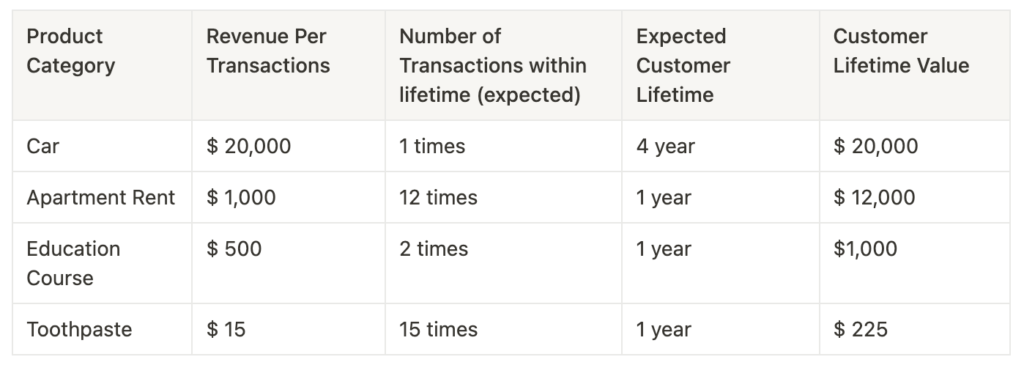
Let examine the table above:
- Let’s say you have an average Cost Per Lead (CPL) of $500. That cost per result sounds reasonable when you’re selling a car valued at $20,000, right?
- A $100 CPL for apartment rentals seems good enough if our expected customer lifetime value is $12,000, but it might be considered high for an education course. To understand this better, we need to consider the business costs of providing our product.
- Now if your product is inexpensive like a toothpaste, SEM will only work if the cost per result (or cost per transaction) is also affordable.
Good marketers often claim that their cost per result is cheap without understanding deeper context. However, great marketers always understand that cost per result is relative to the expected customer lifetime value and the cost of good sold in their business (I will explain this more in later sections).
My personal take here is that SEM works better and more effectively, if you have higher customer lifetime value with a higher dollar margin.
Step 2 – Specific keyword related to your product.
What are people searching for on search engine when they look for your product? Is it something specific and clear? Do people already know what type of product or product category you’re in?
If the answer is no or not sure, start by doing keyword research to understand what does people asking about. My recommendation is start with Google keyword planner, Answer The Public, or SEM Rush.
If the answer is yes, you are in much better position to do SEM. With that clear and specific keyword, we can target & exploit that intent better.
I can share my own experience from my previous company in the below (Table 3.0)

Take a step back for a moment and really try to understand from customer perspective: do people already know the product / service you provided?
If there are more than one specific keyword that can define your product, it is even better!
Step3 – Do the math from a business perspective (cost of good sold).
Most marketer I have come across don’t bother to think or even talk about this; they may feel it is something out of their scope. They see it more on business/finance responsibility and it is too far from their function. Wrong!
Marketing is merely a tool to help a business achieve its goal. We need to apply first principle thinking and think like a founder or an owner. By doing so, I guarantee you already one step ahead compared to other marketer.
Based on Table 2.0, let’s create a new illustrative table below as a sample (Table 3.0):
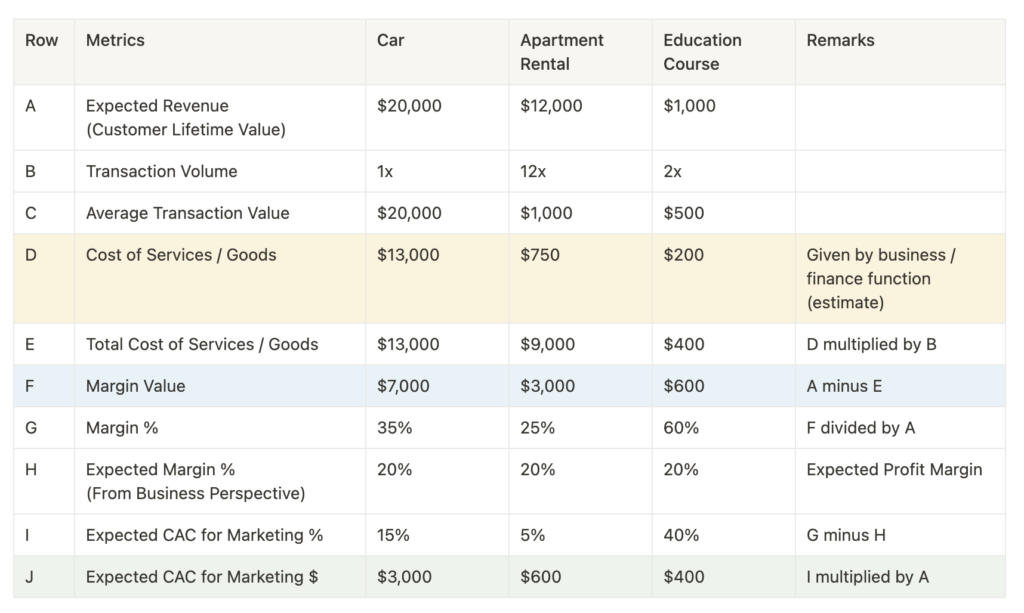
Based on the table above, you will need to align and coordinate with other function within your organization who own the value of cost of good sold or services (Row D). Usually finance or product function understand this better. A rough estimate will suffice; it doesn’t need to be exact.
After that, you will get the margin value (Row F) and percentage (Row G), which you will need to align again with other functions to understand better what type of healthy margin we want to achieve.
Let’s say you want to have a 20% margin percentage on all product. This can help us determine the exact expected CAC for marketing (Row J) to calibrate and optimize towards. While this is a super simplification of the math, the expected CAC for marketing here means we can spend anything up to that amount to get one paying customer.
Of course, some products may require a sales process, so we might need to consider the conversion rate of the sales process too (e.g., from 100 leads, only 4 become paying customers). I hope you get what I mean here!
The key aspect here is to align with other business departments on the cost of good sold and expected margin. This will help us be aware of how much money we can spend from marketing side to be able to acquire paying customer.
Section 3 – How to set up SEM? Best practices and what to do?
Once you did the homework and exercised few steps above, now what? What are the best practices for setting up SEM from the scratch?
There are a few critical aspects you need to do well to get results in SEM, I will do my best to explain & cite relevant links below.
Here are those aspect you need to work on:
Group keyword based on intent value and funnel stage.
What does keyword intent or intent value mean?
You need to be aware that even though we already know the specific type of keyword that work for our products or services, every keyword will have different value.
I once worked with a friend who ran a car coating business in Jakarta, Indonesia. It wasn’t that obvious to us initially that English keyword query like “car coating services” will generate higher quality leads (higher intent, more money to spend) compared to Indonesian keyword “salon mobil” which means “car saloon”.
After experimenting and differentiate those two keywords into two different campaigns or ad group, it became clear to us that people who are searching with English keywords generally came from a higher education background which usually means they have a better income, own more expensive car and have more money to spend.
What about the keyword funnel stage?
When I mentioned ‘funnel’, I’m referring to the potential customer’s buying stage. People who are searching for “2 Bedroom apartment for rent in Singapore” will have higher intent compared to people who are searching “How much does it cost for 2-bedroom apartment Singapore?”
While it seems similar, they are very different. The former keyword means they are already in the market and actively looking for a product/services (Google called this in-market segment, more here) while the later can be translated to someone who is curious or casually browsing for information.
I will share a campaign structure reference later in this article.
What keyword match type should I use? Broad, phrase or exact?
If you are not familiar with keyword match types, read Google’s explanations here. In my opinion, each match type has its own advantages. But I would strongly suggest you to start with phrase match if you just starting to run campaigns on SEM, especially if you are certain on sets of keyword that people are actively searching for.
This is intended to kind of direct Google on specific directions of relevant keywords, so we are not exhausting our budget on irrelevant keyword. If you have limited budget, I don’t recommend you to think about broad match on the early stage.
What about exact match? Once your campaign and keyword performance have stabilised, we can set that up later on maybe couple of weeks or month after we run our initial campaign.
Relevance on three main critical element of google ads and quality score.
Landing Page > Ads (Headline & Description) > Keyword.
Google said this somewhere, could not find the links.
These three need to be aligned with one another, when I mean ‘aligned’ is that each element needs to support one another if we want to have a higher quality score (get more result).
If you bid “Facebook ads digital marketing course” keyword, you need to be sure that the landing page explain more detail on what is it about that keyword because google ads will crawl your website / landing page.
I put the landing page first because it is the biggest element which we have control and pretty much customisable to our own standard. At least compared to limited character that we have on ads headline & description. Read more about that Quality score here.
Setup conversion tracking properly.
Too often, I came across people who run SEM campaign, setting up keyword and ads without properly setting up the conversion tracking on their website. While this is slightly technical, but it is very critical aspect and have to be done perfectly.
Let’s imagine if you’re a striker in a football team, and your manager told to score as many goal as possible. Whatever happened, you just need to kick the ball as often as possible. However, once you step onto a football pitch you see no goalposts anywhere.
Faisal
What will you do? Can you score any goal?
Kicking the ball as often here means spending money, so that means you may spend money without even giving Google direction or guidance. Win for them, lose for us.
Google has a very thorough guidance on setting up conversion tracking here. It is a one time setup, so you will work on this only once (hopefully). If it is too technical for you, please reach out your web developer; they may know and more familiar about this. Alternatively, you can have a session with me on this, I am okay to help you with this.
Expect seasonality or up and down on performance.
Seasonality always occurs in any business, will people search for “Christmas tree” in July? Of course not! Will people search for “summer swimsuit” in December? In this case, the country or city where they are located when they type that keyword intoon Google also matters.
Please understand that if no one or lesser number of people searching for the targeted keyword, our ads may not serving or shown less. So you need to understand the keyword seasonality better here, please use Google keyword planner or Google trend to validate your list of keyword.
Section 4 – Common mistake and what not to do?
Mistake 1 – Not using or even thinking about exclusion.
The most common mistake I always see is this one: telling Google what not to target is as important (if not more important!) than telling it what to target.
Let’s say you do SEM for a music school/activity in East Jakarta, but then you target everyone in Jakarta (which can be 60-70km across from each other), does that make sense? Will the parents of potential students really want to register their children for something that is that far? I don’t know the answer, but you get the idea.
The other is keyword exclusions or negative keyword, if you look closely on search terms report on Google ads, you will be surprised that you may spend money on some keyword that is not even slightly relevant to your product.
I work with my sister on her pottery business, we sell ceramic tableware (bowl, mugs, plate, etc) for B2B. We always focus on “ceramic” as a keyword, little did we know that we were also mistakenly attracting an audience who are looking for other types of ceramics. I am talking about ceramic tiles, ceramic toilet, ceramic sink, etc.
After applying negative keyword of “toilet”, “ceramic tiles”, “ceramic sink”, we managed to exclude that search terms from our campaign and not spending any more money on those type of keywords.
People tend to focus on what they want and not on what they don’t want, which is normal. In SEM, please also think what not to target too, this includes target region, keyword, demographics, etc.
Mistake 2 – Frequent edit or panic within a couple of days of publishing a campaign.
Feels like editing a campaign after publishing it within a day or two because it is not delivering results? Well, I would not recommend you to do that because all advertising platform will always have learning phase(Meta) or learning period(Google).
This basically means within a certain amount of days of ad publication, the algorithm or machine learning will spend your budget aggressively to understand better which type of user or audience that is relevant to your campaign setup.
Make sure you are willing to spend that budget, setting up ads correctly to avoid unnecessary edit within this phase or period.
Now what should I do next?
I hope with this you have more clarity whether it is make sense for you to do SEM for your own business or the company you worked for.
My recommendations is first go talk with the other relevant stakeholder within your organisation, understand their expectations along with the numbers (as illustrated above), and lastly do some research a little bit deeper to understand what is exactly your audience searching for.
I am attaching few links and resources below. In case you need more detailed guidance, feel free to book a call with me through ADPlist (here), I don’t charge any fee because I just love sharing what I know! I hope this help!
Relevant links, tools, and resources to start SEM campaign.
- Google Keyword Planner – here
- Answer The Public – here
- SEM Rush Keyword Magic – here
- Google Trends – here
- Template – SEM Keyword Structure – soon*
- Book 1:1 sessions with me – here (no charges)
Thanks to Asriana Septari for reading drafts of this.
PS: Would love feedback to my writing, feel free to reach out at faisal.tirtonady@gmail.com

